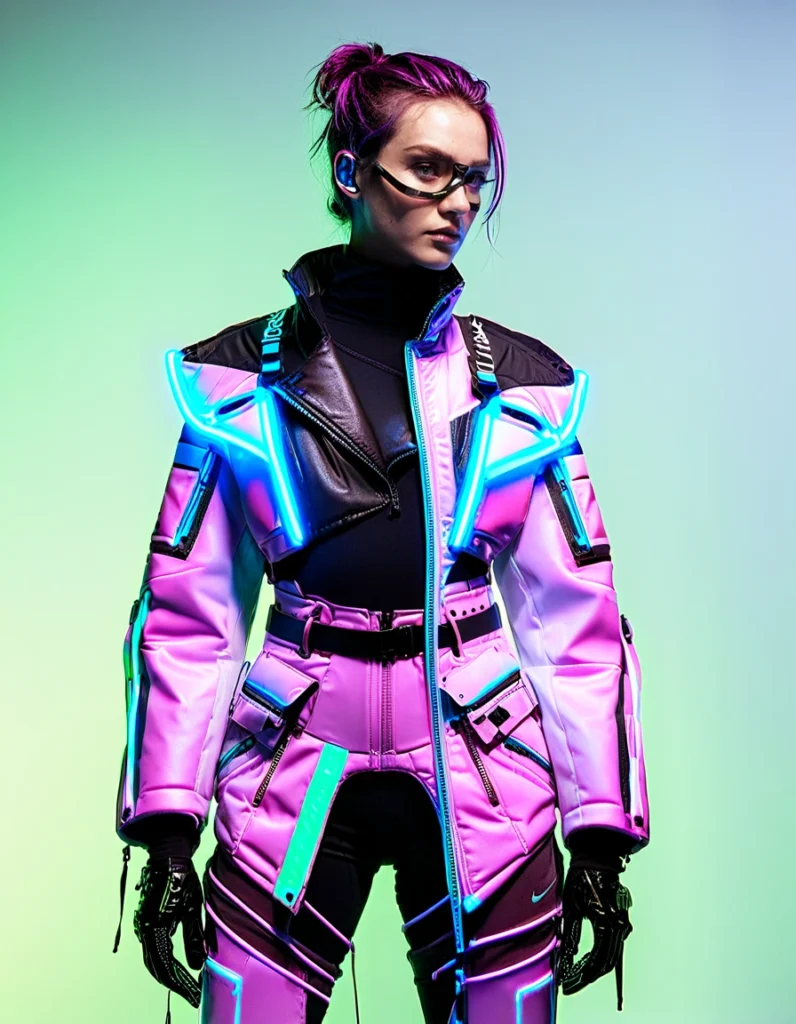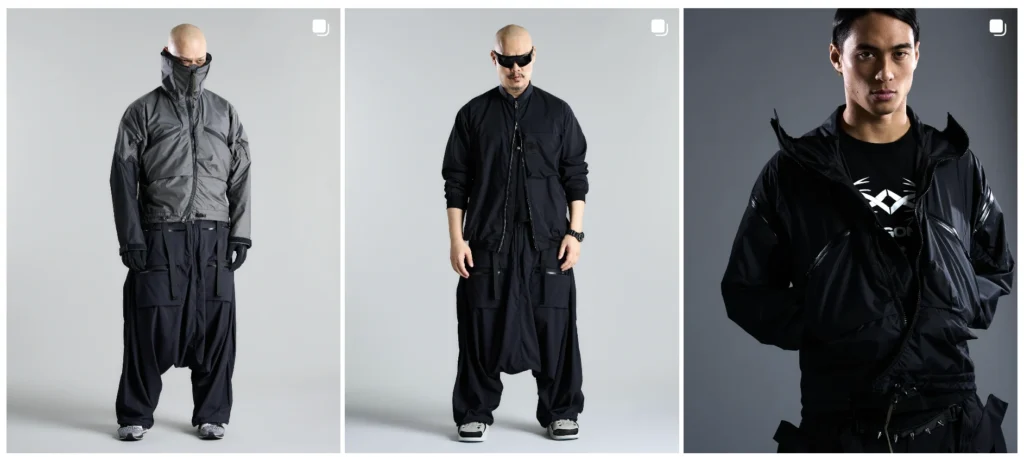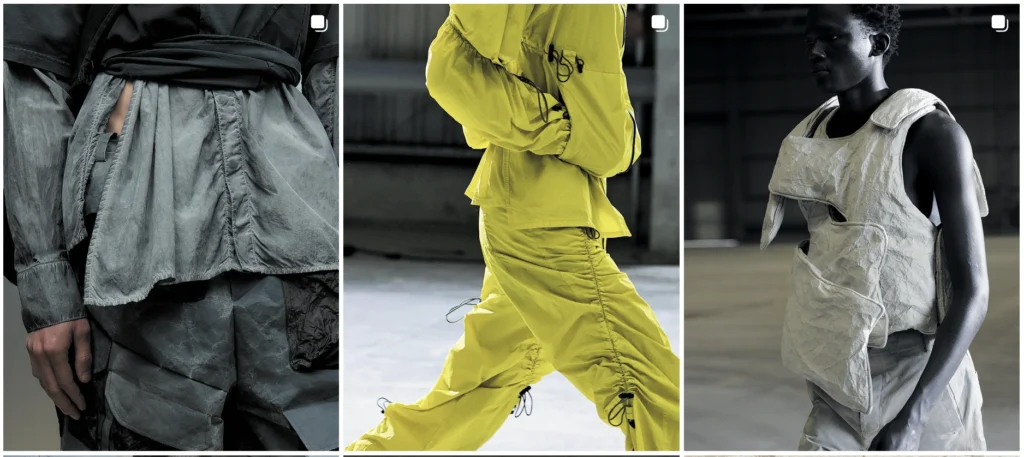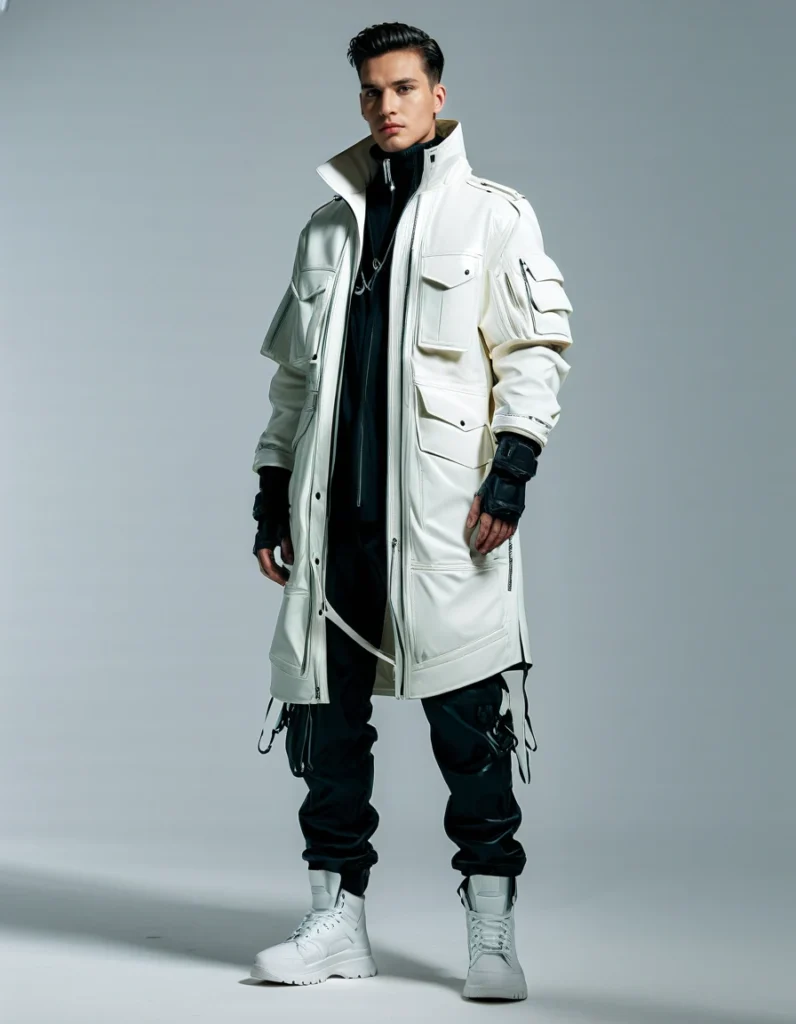Cyberpunk fashion is more than just a trend–it’s a visual story that mixes technology, rebellion, and future visions. If you’ve seen neon lights, bold silhouettes, or gear that looks like it’s from a high-tech world, you’ve probably noticed cyberpunk style. But what exactly is it, and where did it start? Let’s break it down.
What is cyberpunk fashion?

Cyberpunk fashion is a distinctive style blending futuristic technology aesthetics with gritty, urban decay. It visually embodies the “high-tech, low-life” concept central to the cyberpunk genre: a world of advanced artificial intelligence, cybernetics, and neon-lit megacities existing alongside social breakdown, inequality, and rebellion. This fashion rejects conventional norms, favoring an edgy, often dystopian look that incorporates functionality and technological integration.
The core characteristics of the cyberpunk style
- Aesthetic Contrast: Sleek, high-tech elements clash with worn, grungy textures.
- Key Materials: Leather (often distressed), synthetic fabrics (nylon, PVC), and reflective materials mimicking city lights.
- Color Palette: Dominated by blacks, greys, and metallics, dramatically punctuated by neon colors (electric blue, hot pink, acid green).
- Layering & Silhouette: Complex layering of techwear–functional garments often featuring multiple pockets, straps, and adjustable elements. Combines tight-fitting pieces with loose, draped layers.
- Futuristic Accessories: Goggles, respirators, tech-integrated gloves, holographic elements, and visible cybernetic enhancements.
- DIY Ethos & Customization: Heavy emphasis on personalization, modification, and a handmade, anti-establishment feel, often using recycled or repurposed items.
Where Did Cyberpunk Fashion Come From?
Cyberpunk fashion emerged directly from the literary and cinematic cyberpunk genre of the late 20th century.
Literary Roots (Early 1980s)
William Gibson’s seminal novel “Neuromancer” (1984) was foundational. It introduced concepts like “cyberspace” and depicted a world saturated with technology yet socially fragmented, providing rich visual inspiration.
Cinematic Landmark (1982)
Ridley Scott’s “Blade Runner” visually defined the genre. Its rain-slicked, neon-drenched depiction of a decaying future Los Angeles, filled with diverse yet marginalized inhabitants and advanced tech, became the archetypal cyberpunk visual language.
Early Fashion Adoption (Late 1980s – 1990s)
The striking visuals from these works quickly influenced designers and street culture. Key figures like Jean Paul Gaultier and Helmut Lang began incorporating metallic hardware, neon accents, dark layering, and synthetic materials into their collections, translating the genre’s aesthetic into wearable fashion. Streetwear adopted the “hacker chic” look—utilitarian, dark, and edged with rebellion.
Cyberpunk Fashion Today: From Subculture to Mainstream
Cyberpunk fashion has transcended its niche origins to reshape contemporary streetwear, high fashion, and digital design.
The Key Trends of Cyberpunk Fashion
Techwear and Functionality
Techwear is a cornerstone of cyberpunk fashion, emphasizing functionality and durability. Brands like ACRONYM and PSYLO have popularized this trend, offering garments with innovative materials and practical features. These designs often include waterproof and breathable fabrics, reflective surfaces, and integrated technology, such as LED lights and smart pockets.

Military and Tactical Elements
Military-inspired clothing is another significant influence on cyberpunk fashion. Tactical vests, cargo pants, and oversized jackets have become staples, offering a practical and edgy look. These garments often feature multiple pockets, webbing, and camouflage patterns, adding to the overall aesthetic.
Oversized Silhouettes
Oversized and baggy silhouettes are a defining feature of cyberpunk fashion. Harem pants, joggers, and wide-leg pants are popular choices, offering a comfortable yet rebellious fit. These garments often feature unique details like oversized pockets and unconventional closures, enhancing the overall look.
Neon and Reflective Materials
Neon colors and reflective materials are essential to the cyberpunk aesthetic. These elements add a futuristic and vibrant touch to the clothing, reflecting the chaotic energy of cyberpunk cityscapes. Brands often incorporate neon accents and reflective fabrics into their designs to create a striking visual impact.
The impact of cyberpunk fashion on mainstream fashion
High Fashion and Runway Shows
Mainstream designers have increasingly embraced cyberpunk themes, incorporating them into their runway shows and collections. Brands like Yeezy, A-Cold-Wall, and Y-3 have all featured cyberpunk-inspired elements in their designs, blending futuristic aesthetics with practical functionality. These collections often feature monochromatic palettes, metallic accents, and innovative materials.

Streetwear and Everyday Style
The influence of cyberpunk fashion has also trickled down to streetwear and everyday style. Brands are now offering capsule collections that feature reflective materials, futuristic prints, and oversized silhouettes. This accessibility allows fans to integrate elements of cyberpunk into their personal wardrobes, from statement outerwear to minimalist techwear.
The Future of Cyberpunk Fashion
As seen in 2025’s runway shows, cyberpunk continues to influence high fashion. Designers like Rick Owens and Demna Gvasalia (Balenciaga) presented post-apocalyptic couture with armor-like silhouettes and upcycled materials, while New York Fashion Week featured cyberpunk touches like utility clips and Bluetooth accessories. The metaverse also plays a role, with events like Decentraland’s Metaverse Fashion Week (2025) showcasing digital cyberpunk designs.
Looking ahead, cyberpunk’s fusion of sustainability (e.g., recycled PVC, upcycled leather) and futuristic tech (LEDs, smart textiles) positions it as a trend with staying power. Whether through couture or streetwear, it remains a powerful tool for self-expression and social commentary in an increasingly digitized world.
In essence, cyberpunk fashion’s journey from subculture to mainstream is a testament to its adaptability and relevance. By blending dystopian fantasy with real-world concerns, it offers a vision of the future that is both cautionary and empowering.
Explore Cyberpunk Design with Fashion Diffusion

Creating intricate cyberpunk concepts can be time-consuming. Fashion Diffusion offers AI-powered tools to streamline this process. Designers can rapidly generate and iterate on cyberpunk-inspired sketches, apply virtual fabrics and textures, create photorealistic renders on diverse AI models, and experiment with futuristic backgrounds.
Explore Fashion Diffusion today and discover how AI can transform your fashion visuals—no technical skills needed, just endless creativity!
FAQs
Cyberpunk fashion style is a distinctive and influential aesthetic that originated in the world of science fiction and has since made a significant impact on the fashion industry. It combines elements of high technology, dystopian themes, and a rebellious spirit to create a look that is both futuristic and edgy.
Neon colors, metallic textures, utilitarian accessories (straps, goggles), holographic/reflective fabrics, and the contradictory aesthetic of “high tech meets decay.”
Cybercore leans more into Y2K rretro-futurism (sequins, low-rise), while cyberpunk emphasizes dystopian darkness and functionality.





